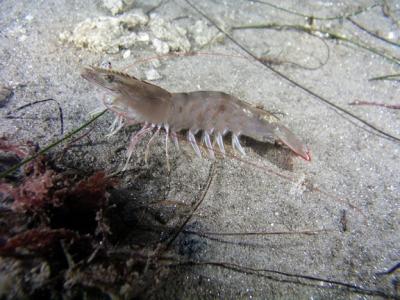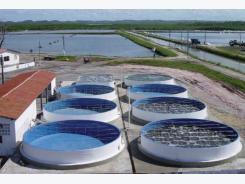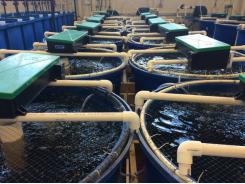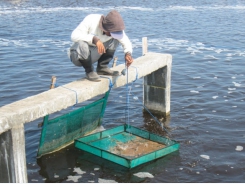Two-Stage Selection Key For Fast Shrimp Growth In Mexico

Summary: The largest shrimp hatchery in Mexico has implemented a two-stage selection program based on body weight at 28 days of age and and body weight at 130 days. This approach increases the genetic gain for growth at harvesting age, since body weight at 28 days is highly correlated with body weight at 130 days. After successive family selections, the top 5 to 10% of the shrimp produce a new generation of 300 families for the next year.
Mexican shrimp producers face growing international competition and hence have improved their management practices over time. They demand healthy, high-quality, fast-growing shrimp postlarvae for their commercial ponds. Mexican hatcheries therefore face challenges to design better breeding programs for the shrimp industry.
At Maricultura del Pacífico, the largest shrimp hatchery in Mexico, recent changes for better breeding included the implementation of a two-stage selection program based on body weight at 28 days of age and growth and body weight at 130 days of age. This two-step approach increases the genetic gain for growth at harvesting age, since body weight at 28 days is highly correlated with body weight at 130 days of age.
The possibility of increasing the number of shrimp families to be tested in selection experiments for growth performance at early ages allows the selection of the best 150 families out of 300 at each cycle. Although at this early stage, the family selection emphasis is based on growth and predicted breeding values, families with relatively low survival PVBs are discarded.
Initial Selection
Selection of body weight at 28 days is based on an animal model and best linear unbiased prediction (BLUP) methodology. BLUP is a method of statistical analysis in which numerical scores are given to traits and compiled as predictions for future use. The model includes random environmental and animal effects, plus the fixed effects associated with the hatchery production process, such as position in the larvae production area.
Once the 150 families are selected, the two family tank replicates are mixed. When they reach approximately 2-g body weight, 450 postlarvae (PL) from every family are marked with elastomer tags in order to be identified in the pond performance tests, while the rest of the postlarvae are kept under environmentally controlled conditions with maximized sanitation at the genetic nucleus of the hatchery.
Elastomerized postlarvae from the selected families are then seeded in three ponds with different management representing three common management systems found in Mexico. Densities of 10 and 30 PL/m2 are used in sandy soil, while 180 PL/m2 are used with concrete bottoms. A performance test for body weight after 90 days is carried out, and hence, at approximately 130 days of age, each shrimp of every family is individually weighed.

Figure 1. Two-stage breeding program at Maricultura del Pacífico.
Data Analysis
Data from this process is then analyzed for body weight and survival using a model that includes the animal effect, maternal effect and fixed effects of pond management and age at harvesting as a covariate, since small age differences between families associated with the production process in the hatchery need to be adjusted.
Again, BLUP is used as the evaluation method. At this second stage, a selection index that includes body weight (8/9) and survival (1/9) is used to select the best 70 families out of the 150 that entered the experiment.
In the meantime, the full siblings of the 150 families kept in the genetic nucleus have passed through an additional mass within-family selection process that keeps approximately the top 30% of each family. This additional step guarantees that only the best animals within family are chosen based on growth, and the best families are selected.
After the best 70 families are selected, the top 5 to 10% of these shrimp are selected in another mass selection. These animals will produce the new generation of 300 families for the next year. This process repeats year after year
The annual generation of the 300 families minimizes inbreeding by controlling the mating process using artificial insemination with two females per male. It is also based on the relationships between potential mates from the pedigree. The actual inbreeding average of the population in the genetic nucleus is 3.31%
Commercial, Conservation Lines
The best four to six families from this second stage are also used to establish the commercial line of the hatchery. This process consists of mating two sets of families with the lowest additive relationship, ideally a family ranked first with a family ranked fourth, and a family ranked second with a family ranked third.
Animals from these two crosses are mass selected using the top 10%, and the two lines are then crossed to yield the commercial line. Figure 1 summarizes the breeding program of Maricultura del Pacífico.
The hatchery also has a second line to preserve genetic variation. The selection index in this line gives a relatively higher weight to survival (1/5) compared to the growth line (1/9). The line started in 2007, and some experiments within it regarding the effects of inbreeding on growth and survival are in the process of being analyzed. Families from this conservation line will likely be considered for growth to restore lost genetic variation when necessary in the future.
Authors:
Héctor Castillo-Juárez, Ph.D. - Mejoramiento Genético Animal y Biometría Departamento de Producción Agrícola y Animal Universidad Autónoma Metropolitana, Unidad Xochimilco Calzada del Hueso 1100 México 04960 D.F. México hcjuarez@correo.xoc.uam.m
Hugo. H. Montaldo, Ph.D. - Universidad Nacional Autónoma de México
Gabriel R. Campos-Montes, Ph.D. - Maricultura del Pacífico, S.A. de C.V. Mazatlán, Sinaloa, México
Related news
Tools

Phối trộn thức ăn chăn nuôi

Pha dung dịch thủy canh

Định mức cho tôm ăn

Phối trộn phân bón NPK

Xác định tỷ lệ tôm sống

Chuyển đổi đơn vị phân bón

Xác định công suất sục khí

Chuyển đổi đơn vị tôm

Tính diện tích nhà kính

Tính thể tích ao




 Effective Management Of WSSV In Shrimp - A…
Effective Management Of WSSV In Shrimp - A…  Recirculating Aquaculture Tank Production Systems An Overview of…
Recirculating Aquaculture Tank Production Systems An Overview of…